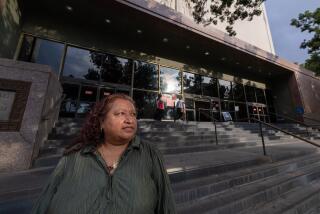Child Support Panel Frustrated
The panel charged with overseeing the Los Angeles County district attorneyâs problem-plagued child support collection program grew so exasperated with the operation Thursday that members considered recommending that the $100-million-a-year agency be put into receivership.
Although that extraordinary proposal was not adopted by the countyâs Family Support Advisory Board, it reflected the mounting frustration among some members over management of the child support program administered by Dist. Atty. Gil Garcettiâs office.
âIt is impossible to sit here as a member of this group and feel that you are adequately discharging your duties,â said the panelâs chairwoman, Betty Nordwind, executive director of the Harriet Buhai Center for Family Law.
Board member Jane Preece--who proposed the receivership and ended up on the losing end of the lopsided vote--said there was no choice but to ask that someone else run the child support agency. âI just see an inability to manage the department,â said Preece, an attorney with the Legal Aid Foundation of Los Angeles who, like Nordwind, has often clashed with Garcettiâs office.
Board member Deborah Taylor opposed the motion, saying that recommending such a âdrastic moveâ would jeopardize the panelâs credibility.
She also said control of the child support agency cannot simply be wrested from the district attorney because he is an elected official. âYou have to throw him out at the polls if you want to get rid of him,â she said.
Much of the frustration during the contentious, 2 1/2-hour meeting centered on the inability of the district attorneyâs office to deliver reports sought for months by the advisory board.
Asked repeatedly about reports on case closures and other key matters, several top aides to Garcetti said they either had not yet obtained the information or could not immediately address the issues because they needed the help of technical staff.
Thus, Garcettiâs representatives said, they could not answer questions on issues including last yearâs unprecedented closure of more than 240,000 cases, how cases are assigned to workers, or the basic percentage rate of collections.
That last matter loomed most significant Thursday when a state official who oversees child support collections used a much different methodology than Garcettiâs office to calculate the percentage of child support cases in which money is collected.
This week--responding to a Times investigation that outlined numerous problems within the office, including a dismal collection rate--Garcettiâs office assured the county Board of Supervisors in writing that it was collecting support this year on more than 100,000 of its 500,000 cases, a 20% rate. That number, the office said, was adjusted to remove double counting of collections.
But Richard A. Williams of the state Department of Social Services suggested Thursday that the panel use a different calculation to determine the percentage of cases with collections. The district attorneyâs approach could still double-count some collections, he confirmed in any interview.
Using Williamsâ methodology, Los Angeles County collects support on an average of 70,000 cases per month. That would place the rate at 14% now, and 10% last year.
Late Thursday, Garcettiâs office said it would no longer comment on child supportissues until the release of a report to the Board of Supervisors next month. It also declined to further explain its calculations.
In its series, The Times, relying on the figures it and the advisory board were given by Garcettiâs office, found that the agency collects current and back support on 12% of its cases and less than 8% in currently due child support.
Those figures do not take into account the hundreds of thousands of cases deemed uncollectable by Garcettiâs office since last year--a number that would drive its collection rate lower.
In its series, The Times reported that the agency not only closed about 240,000 cases last year but that caseworkers were instructed--in a training bulletin issued by top administrators--not to reopen many cases even when new information is available.
That directive, which would prevent taxpayers from recovering the money spent for families on welfare, was the first issue addressed by the advisory board Thursday.
âThe only reasonable conclusion,â Legal Aidâs Preece told Garcettiâs representatives, âis that you are trying to keep caseloads down and [collection] statistics up.â
Although denying that the office had such a policy, Garcettiâs aides could not provide any evidence that the training bulletin was ever withdrawn.
Later in the meeting, after the panel asked how the agency processes its cases, Garcettiâs office again came under fire when it could not explain the procedure or when it would comply with a key recommendation of last yearâs Price Waterhouse audit. The audit urged that employees have more direct responsibility for--and accountability over--specific cases.
Declaring that such an examination would be costly and time-consuming, Deputy Dist. Atty. Dennis Snapp told the panel that agency officials âsimply have not gotten to the point yet of issuing a report . . . that is accurate and fair on case processing.â
The panel chairwoman said such explanations leave the advisory board feeling âsandbagged.â
âIf in 1998, nobody at the agency can write a coherent description of how the typical case is handled . . . or how the system is supposed to work . . . then I think you have a very, very, very serious problem,â Nordwind said.
More to Read
Sign up for Essential California
The most important California stories and recommendations in your inbox every morning.
You may occasionally receive promotional content from the Los Angeles Times.










